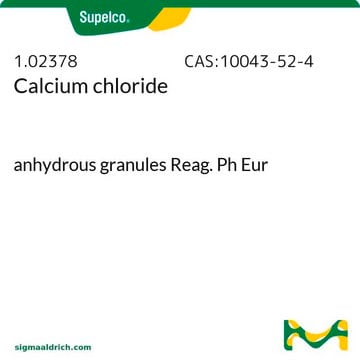Products may be shipped at a different temperature than the recommended long-term storage temperature. If the product quality is sensitive to short-term exposure to conditions other than the recommended long-term storage, it will be shipped on wet or dry-ice. If the product quality is NOT affected by short-term exposure to conditions other than the recommended long-term storage, it will be shipped at ambient temperature. As shipping routes are configured for minimum transit times, shipping at ambient temperature helps control shipping costs for our customers. For more information, please refer to the Storage and Transport Conditions document: https://www.sigmaaldrich.com/deepweb/assets/sigmaaldrich/marketing/global/documents/316/622/storage-transport-conditions-mk.pdf
C5670
Calcium chloride
anhydrous, BioReagent, suitable for insect cell culture, suitable for plant cell culture, ≥96.0%
Synonyme(s) :
CaCl2, Calcium dichloride
Sélectionner une taille de conditionnement
Sélectionner une taille de conditionnement
About This Item
Produits recommandés
Qualité
anhydrous
Niveau de qualité
Pression de vapeur
0.01 mmHg ( 20 °C)
Gamme de produits
BioReagent
Essai
≥96.0%
Forme
powder
Technique(s)
cell culture | insect: suitable
cell culture | plant: suitable
Pf
772 °C (lit.)
Chaîne SMILES
[Cl-].[Cl-].[Ca++]
InChI
1S/Ca.2ClH/h;2*1H/q+2;;/p-2
Clé InChI
UXVMQQNJUSDDNG-UHFFFAOYSA-L
Vous recherchez des produits similaires ? Visite Guide de comparaison des produits
Description générale
Application
transfection of eukaryotic cells with either plasmid DNA or high molecular weight genomic DNA. The CaCl2-mediated electroporation of E. coli with the plasmid DNA pBR322 has been studied. A protocol for the concentration of virus vectors that uses CaCl2 has been published.
Notes préparatoires
Mention d'avertissement
Warning
Mentions de danger
Conseils de prudence
Classification des risques
Eye Irrit. 2
Code de la classe de stockage
13 - Non Combustible Solids
Classe de danger pour l'eau (WGK)
WGK 1
Point d'éclair (°F)
Not applicable
Point d'éclair (°C)
Not applicable
Faites votre choix parmi les versions les plus récentes :
Certificats d'analyse (COA)
Vous ne trouvez pas la bonne version ?
Si vous avez besoin d'une version particulière, vous pouvez rechercher un certificat spécifique par le numéro de lot.
Déjà en possession de ce produit ?
Retrouvez la documentation relative aux produits que vous avez récemment achetés dans la Bibliothèque de documents.
Les clients ont également consulté
Articles
Calcium is an ionically stable divalent cation with important beneficial and toxic properties in cell culture. It is a component of a wide range of cell culture media.
-
How is shipping temperature determined? And how is it related to the product storage temperature?
1 réponse-
Utile ?
-
-
How can I determine the shelf life / expiration / retest date of this product?
1 réponse-
If this product has an expiration or retest date, it will be shown on the Certificate of Analysis (COA, CofA). If there is no retest or expiration date listed on the product's COA, we do not have suitable stability data to determine a shelf life. For these products, the only date on the COA will be the release date; a retest, expiration, or use-by-date will not be displayed.
For all products, we recommend handling per defined conditions as printed in our product literature and website product descriptions. We recommend that products should be routinely inspected by customers to ensure they perform as expected.
For products without retest or expiration dates, our standard warranty of 1 year from the date of shipment is applicable.
For more information, please refer to the Product Dating Information document: https://www.sigmaaldrich.com/deepweb/assets/sigmaaldrich/marketing/global/documents/449/386/product-dating-information-mk.pdfUtile ?
-
-
What is the procedure for preparing a 2 M solution using calcium chloride and calcium chloride dihydrate?
1 réponse-
The molecular weight for calcium chloride dihydrate is 147.01 g/mol, so a 2 M solution would be 294 g/L. Similarly, the molecular weight for calcium chloride is 110.98 g/mole, so a 2 M solution would be 222 g/L. Therefore, a 2 M solution of calcium chloride dihydrate (such as C7902) would be 294 g/L with a molecular weight of 147.01 g/mol.
Utile ?
-
Filtres actifs
Notre équipe de scientifiques dispose d'une expérience dans tous les secteurs de la recherche, notamment en sciences de la vie, science des matériaux, synthèse chimique, chromatographie, analyse et dans de nombreux autres domaines..
Contacter notre Service technique










